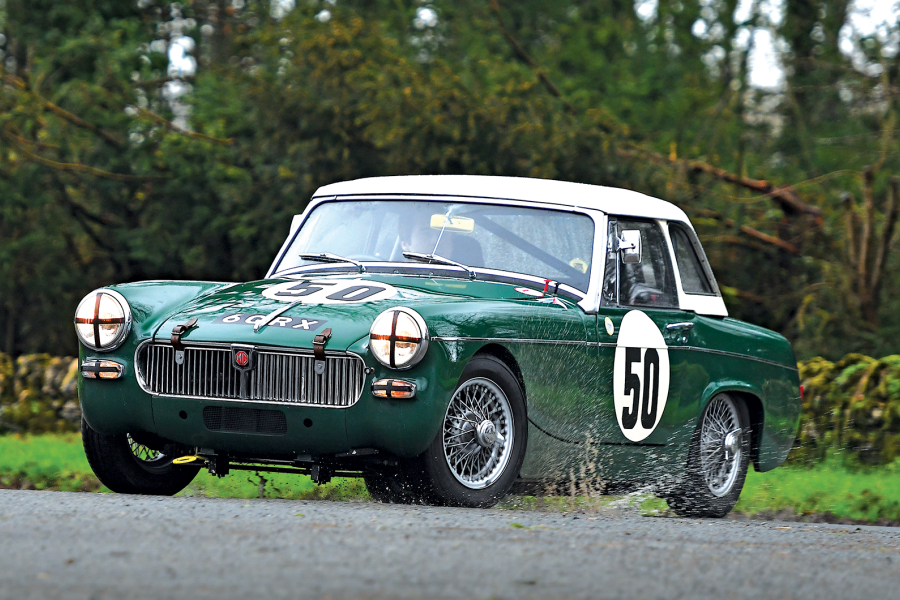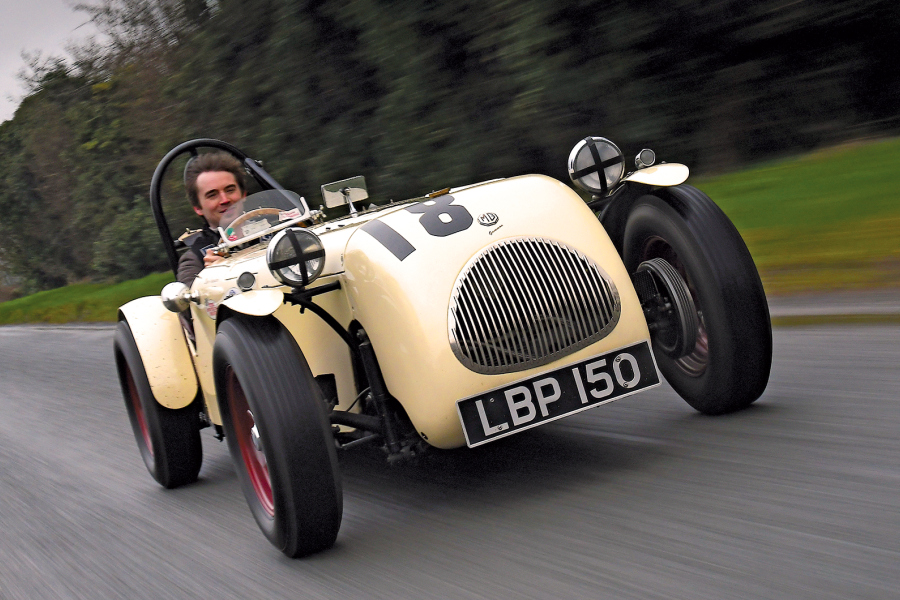The featured MkI Midget – built in September 1961 and one of the earliest survivors – looks like a completely different car, and bigger thanks to the car’s squared-off extremeties.
When you get inside, however, the bloodline is clear.
The seats and dashboard – with its slightly random assortment of switches and dials – are little changed from the Frogeye, and, while the view down the bonnet is dominated by converging wings rather than prominent headlights, you are in little doubt that these cars are, in essence, the same under the skin.
The Austin-Healey Sprite MkIV sits on 13in wire wheels
Each generation is pretty tight inside, but the driving position gradually evolves from a somewhat ‘sit up and beg’ feeling with a big, thin-rimmed steering wheel close to your chest, to a more sporting attitude that places you in the car rather than on it.
Certain driving characteristics remain constant throughout, such as the short-throw gearchange; the sharp steering; the surprising amount of body roll under hard cornering; and the slightly disappointing brakes – not even the 1500 had a servo.
The differences come mostly from the engine fitted. As you would expect, the 948cc unit in the Frogeye and MkI Midget lacks torque, and you have to wait patiently for it to build up a head of steam.
The Austin-Healey Sprite’s 1275cc engine, taken from the Mini Cooper ‘S’, performs well
Our featured MkII Midget features a few period-style upgrades to its 1098cc engine, and doesn’t get on cam until about 2500rpm.
It pulls strongly from there, with that familiar fruity exhaust note that can only come from an A-series and, in this spec at least, feels every bit as fast as the 1275cc models higher up the rev range.
Where those cars score, however, is in their blend of torque and power. Prod the throttle and they eagerly jump forward with no hesitation.
BL’s facelift of the MG Midget meant a new grille, black sills and, later, round rear wheelarches
As an everyday proposition for the public road – and modern traffic – they would no doubt be the most usable of the A-series cars.
The 1500 Triumph unit might not have the same character, but it does offer the strongest performance.
Owner David Storer likes to use his cars enthusiastically and issues instructions that I should do the same.
The engine has been lightly tweaked and responds instantly to throttle inputs; as you’d expect, it has noticeably more torque than the 1275cc models.
The MG Midget MkIII has better seats plus a large, three-spoke steering wheel
Even with the increase in ride height and the extra weight from those impact bumpers – which, to me, look more awkward on a Midget than they do on an MGB – the initial turn-in remains sharp, although if you get your entry wrong the car will run wide at the exit.
The Midget 1500’s natural tendency when being pushed, however, is towards oversteer, but it is very much of the controllable variety rather than being snappy.
The limits of the Midget’s roadholding are soon exceeded and, if you’ve done your braking and gearchanging before the corner and are back on the throttle, the rear will slowly break away.
The MkIII represents the last hurrah for the 1275cc MG Midget
You don’t even need to do much by way of correction – within reason, it will go only so far and then just sit there.
Period magazine road tests reported that the 1500 would bite if you panicked and lifted off the throttle at this point, but if you don’t the Midget will make you feel like a hero as you drift out of corners.
It’s predictable, dependable – and terrific fun.
And that applies to whichever type of Spridget you go for, which explains why they were so popular as competition cars in period.
Mild upgrades make the MG Midget 1500 great fun to drive
Not long after the Frogeye was introduced, John Sprinzel and Tommy Wisdom entered the tortuous 1958 Alpine Rally, finishing 15th and 19th respectively.
Healey was charged with looking after official motorsport outings, and made regular raids on Sebring.
In 1960, one car was entered for the 1000cc class in a new four-hour GT race at the famed American circuit.
Harry Weslake tweaked the engine and, in a further attempt to close the gap to the twin-cam Abarths, Stirling Moss was employed alongside Sprinzel.
Clockwise from top: the MG Midget 1500 has a Triumph-sourced ‘four’; black-leather cabin; RoStyle wheels were standard fit
The engine overheated in practice, but Moss brought the Frogeye home in second place.
Sprinzel would go on to build a handful of Sebring Sprites with aluminium bodywork by Williams & Pritchard: Moss drove one at the Florida venue in 1961.
As the 1960s progressed, the cars continued to be seen in racing – from the Targa Florio to the Nürburgring and Le Mans.
The degree of factory commitment at this stage can be gauged by the entry for the 1962 Sebring 3 Hours: 9251 WD was driven by actor Steve McQueen and finished ninth; Innes Ireland was seventh in 9252 WD; Pedro Rodríguez came sixth in 9253 WD; and in third place behind the Abarths was Moss in 9254 WD. Not a bad driver line-up, all in all.
The MG Midget 1500 sports controversial Federal impact bumpers
That racing success provided a welcome marketing boost and proved the cars’ sporting prowess against worthy oppostion, but it is not the context in which they are now coveted.
Instead, it is their sheer accessibility that remains their most powerful draw.
Few genuinely classic two-seaters offer a comparable blend of affordability and thrills, and each one boasts something on which it is very hard to put a price: the ability to put a smile on your face every time you drive it.
Images: Tony Baker
Thanks to: The Midget and Sprite Club; Mike Authers
This was first in our July 2014 magazine; all information was correct at the date of original publication
Arkley SS
The Arkley SS melded cheeky looks with better handling
Perhaps the best known of the Spridget derivatives was the Arkley SS.
Designed by John Britten, it featured glassfibre front and rear sections but retained the donor’s floorpan, suspension, running gear, hydraulics and wiring loom.
The kit was suitable for all models from the Frogeye onwards, and was made by the Lenham Motor Company in Kent.
Arkley could convert the car for you, or you could elect to do it yourself, and it is thought that around 900 were sold.
While the standard interior was retained – with the exception of a misleading six-speed gearknob – the reworked styling was intended to evoke traditional sports cars from the likes of Morgan, with the brochure promising ‘a return to sports-car sanity and open-air freedom’.
The reduction in weight certainly brought about an improvement in performance and handling, with Cars and Car Conversions stating: ‘Slowing down for corners in an Arkley seems outdated.’
The increase in grip came mostly from the chunky 7in wheels that Arkley claimed were the widest available on a car of this size, shod with low-profile tyres.
Enjoy more of the world’s best classic car content every month when you subscribe to C&SC – get our latest deals here
READ MORE
Shared heart: MG Midget 1500 vs Triumph Spitfire 1500
Baby classic sports cars do battle: Honda S800 vs Fiat Sport Spider vs MG Midget
Triumph Spitfire vs MGB vs Lotus Elan: a new dawn
James Page
James Page is a regular contributor to – and former Editor of – Classic & Sports Car




